Scutula is a genus of lichenicolous fungi in the family Ramalinaceae.
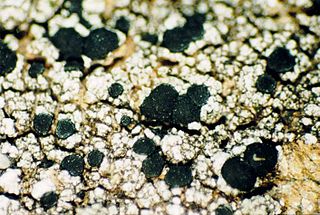
The Lecanoraceae are a family of lichenized fungi in the order Lecanorales. Species of this family have a widespread distribution.
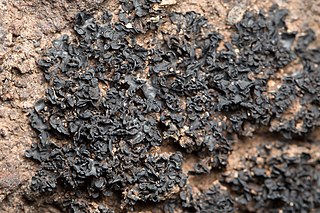
The Lichinaceae are a family of ascomycete fungi. Most species are lichenized with cyanobacteria, and have a distribution largely in temperate regions.
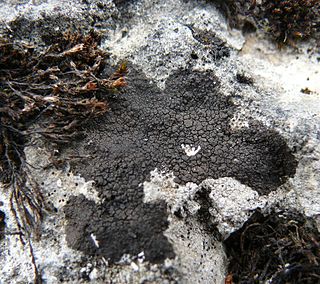
The Verrucariaceae are a family of mostly lichenised fungi in the order Verrucariales. The lichen-forming species, which comprise the vast majority of the family, have a wide variety of thallus forms, and include crustose (crust-like), foliose (bushy), and squamulose (scaly) representatives. Several characteristics of the spore-bearing structures, the ascomata, define the family, including their perithecioid form–more or less spherical or flask-shaped, with a single opening and otherwise completely enclosed by a wall. Squamulose members of the Verrucariaceae with simple ascospores, and without algae in the spore-bearing region are known as catapyrenioid lichens; there are more than 80 of these species. The family has several dozen lichenicolous (lichen-dwelling) examples, including a few genera that contain solely lichenicolous members. An unusually diverse variety of photobiont partners have been recorded, mostly green algae, but also brown algae and yellow-green algae.
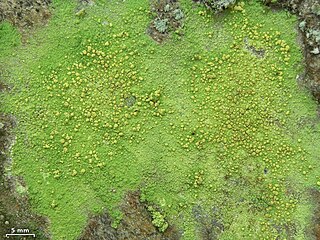
Psilolechia is a genus of four species of crustose lichens. It is the only member of Psilolechiaceae, a family that was created in 2014 to contain this genus.
Clavascidium is a genus of lichens in the family Verrucariaceae. The genus was circumscribed in 1996 by Austrian lichenologist Othmar Breuss. Because the type species of the genus, Clavascidium umbrinum, has been shown using molecular phylogenetics to belong to genus Placidium, Cécile Gueidan and colleagues proposed to unite Clavascidium with Placidium in a 2009 publication. Despite this, the genus has been retained in recent publications of fungal classification.

Thelidium is a genus of lichen-forming fungi in the family Verrucariaceae. The genus was circumscribed in 1855 by Italian lichenologist Abramo Bartolommeo Massalongo, who assigned Thelidium amylaceum as the type species.

Parmotrema is a genus of lichen belonging to the family Parmeliaceae. It is a large genus, containing an estimated 300 species, with a centre of diversity in subtropical regions of South America and the Pacific Islands.
Frigidopyrenia is a fungal genus in the family Xanthopyreniaceae. It is a monotypic genus, containing the single species Frigidopyrenia bryospila, a subarctic crustose lichen. This lichen was originally described by Finnish lichenologist William Nylander in 1864 as Verrucaria bryospila. It was shuffled to several genera in its taxonomic history before Martin Grube circumscribed Frigidopyrenia in 2005 to contain it. As of 2017, no molecular sequence data was available for Frigidopyrenia.
Sagiolechia is a genus of lichen-forming fungi in the family Sagiolechiaceae. The genus was circumscribed by lichenologist Abramo Bartolommeo Massalongo in 1854, who assigned Sagiolechia protuberans as the type species. The family Sagiolechiaceae was proposed in 2010 to contain Sagiolechia as the type genus, and genus Rhexophiale; molecular phylogenetic analysis showed that these two genera formed a distinct clade in the Ostropales.

Rhizocarpaceae is a family of crustose, lecideoid, lichen-forming fungi and together with the family Sporastatiaceae it constitutes the order Rhizocarpales in the Ascomycota, class Lecanoromycetes.

Rhizocarpon is a genus of crustose, saxicolous, lecideoid lichens in the family Rhizocarpaceae. The genus is common in arctic-alpine environments, but also occurs throughout temperate, subtropical, and even tropical regions. They are commonly known as map lichens because of the prothallus forming border-like bands between colonies in some species, like the common map lichen.

Varicellaria is a genus of crustose lichens. It is the only genus in the family Varicellariaceae.
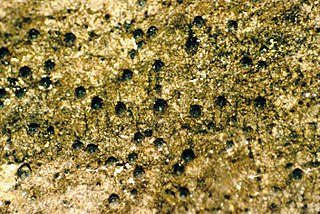
Scoliciosporum is a genus of lichens in the family Scoliciosporaceae.

Solenopsora is a genus of lichen-forming fungi in the family Catillariaceae. It has 15 species, with a mostly Northern Hemisphere distribution.

Sporastatiaceae is a small family of crustose lichens in the order Rhizocarpales. It contains two genera, Sporastatia and Toensbergia, with a total of five species. Sporastatiaceae was circumscribed in 2013 by Mika Bendiksby and Ernst Timdal.
Toensbergia is a genus of lichen-forming fungi in the family Sporastatiaceae. The genus was circumscribed by Mika Bendiksby and Einar Timdal in 2013. The genus name honours Norwegian lichenologist Tor Tønsberg, "in appreciation of his important work on sorediate, corticolous lichens". The type species is Toensbergia leucococca, which was formerly classified in genus Hypocenomyce, presumably due to its resemblance to Hypocenomyce xanthococca.

Rhizocarpales are an order of lichen-forming fungi in the subclass Lecanoromycetidae of the class Lecanoromycetes. It has two families, Rhizocarpaceae and Sporastatiaceae, which contain mostly crustose lichens.

Mastodia is a genus of lichen-forming fungi in the family Verrucariaceae. It has six species. The genus was circumscribed in 1847 by Joseph Dalton Hooker and William Henry Harvey. The type species, Mastodia tessellata, is a bipolar, coastal lichen. It forms a symbiotic association with the macroscopic genus Prasiola; this is the only known lichen symbiosis involving a foliose green alga. Studies suggest that throughout its geographic range, the lichen comprises two fungal species and three algal lineages that associate.
Strangospora is a genus of lichen-forming fungi. It is the only genus in the family Strangosporaceae, which itself is of uncertain taxonomic placement in the Ascomycota. It contains 10 species.













